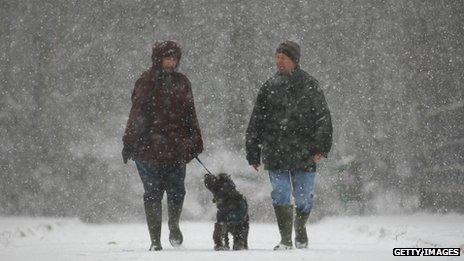Who, What, Why: What is wind chill factor?
- Published

Weather forecasters in the UK are warning that it will feel far colder than the actual temperature. It's the wind chill factor. But what does the term mean?
The Met Office calls wind chill the "feels like temperature".
It forecast a temperature of 0C for the City of London at 09:00 GMT on Monday. But the temperature would feel like -6C, it said.
By 21:00 GMT on Monday the temperature was expected to drop to -2C but would feel like -9C, the forecast says, external.
Why is there such a big difference?
The human body has a core temperature of roughly 37C. The air around it is usually below 37C - meaning that we lose heat from anywhere not covered by clothing. When it is still we are mostly losing heat by convection.
But when a breeze hits the face the initial heat loss is from conduction. The wind cools the temperature of the skin almost to air temperature, says Chris Shepherd, from the Institute of Physics. Convection also plays a part, helping to circulate the warm air away from the face. If the skin is wet there will be additional cooling from the evaporation of moisture.
The stronger the wind the faster the cooling. The lower the temperature, the more impact the wind has.
The equivalent of wind chill for warmer temperatures is the heat index - humidity is a major factor. These terms are needed because degrees Celsius doesn't always give a full picture of how it feels to be caught in a blizzard or trying to sleep in high humidity.
The Met Office's "feels like temperature" takes into account expected air temperature, relative humidity and the strength of the wind at around 5 feet (1.5m) - the typical height of a person's face. This is combined with an understanding of how heat is lost from the human body during cold and windy days.
Wind chill is vitally important information for the public, says Ross Reynolds, senior teaching fellow at Reading University's meteorology department. It will affect not just how you feel but how long you can stay in the cold. "It's there to warn the public. It might have an impact on how quickly you get frostbite."
A purely scientific way of measuring it would be watts per square metre. But it would be meaningless to most people, Reynolds says. Hence the arrival of the "feels like" term.
However there is still no universally agreed formula for wind chill. It is not an exact science and depends on what you want to measure.
One of the first wind chill measures, known as Siple-Passel, was based on observing how quickly bottles of water froze in the Antarctic wind.
Later indices attempted to apply it to human physiology. Humans were tested naked in wind tunnels to assess the impact on temperature. The height used for measuring the wind was 10m - far above street level.
In a bid to get a more realistic measure, the UK in 2008 adopted a new system - JAG/TI (Joint Action Group for Temperature Indices). The formula, which is used by Canada, the US and the Netherlands, is becoming the international standard. It is the system used to calculate the Met Office's "feels like" temperatures.
JAG/TI calculates wind chill by looking at a clothed person walking at a speed of 3mph. It considers how much heat a person loses from their bare face.
One factor not covered is moisture. JAG/TI considers only people who are dry.
Environment Canada provides a rough guide, external to calculating wind chill. For instance, 0C will feel like -5C in a 20km/h wind and -8C in a 50km/h wind.
The risk of frostbite increases rapidly when wind chill values go below -27C, the agency warns.
Tamsin Gray, a meteorologist with the British Antarctic Survey, says the wind is a crucial factor when going outside in Antarctica.
"It can be -45C and you can cope quite happily as long as it's not windy. But if it's windy at -30C it's much worse."
After ten minutes in a blizzard at -30C she recalls having to use a hair dryer to remove her clothes, which had frozen rigid. But when the wind drops you can venture out, sometimes not wearing much.
"You can be outside in -15C wearing a T shirt and jeans in calm conditions with the sun shining. The coldest I've ever been out in was -50C. It was not particularly unpleasant because it was really still."
You can follow the Magazine on Twitter, external and on Facebook, external